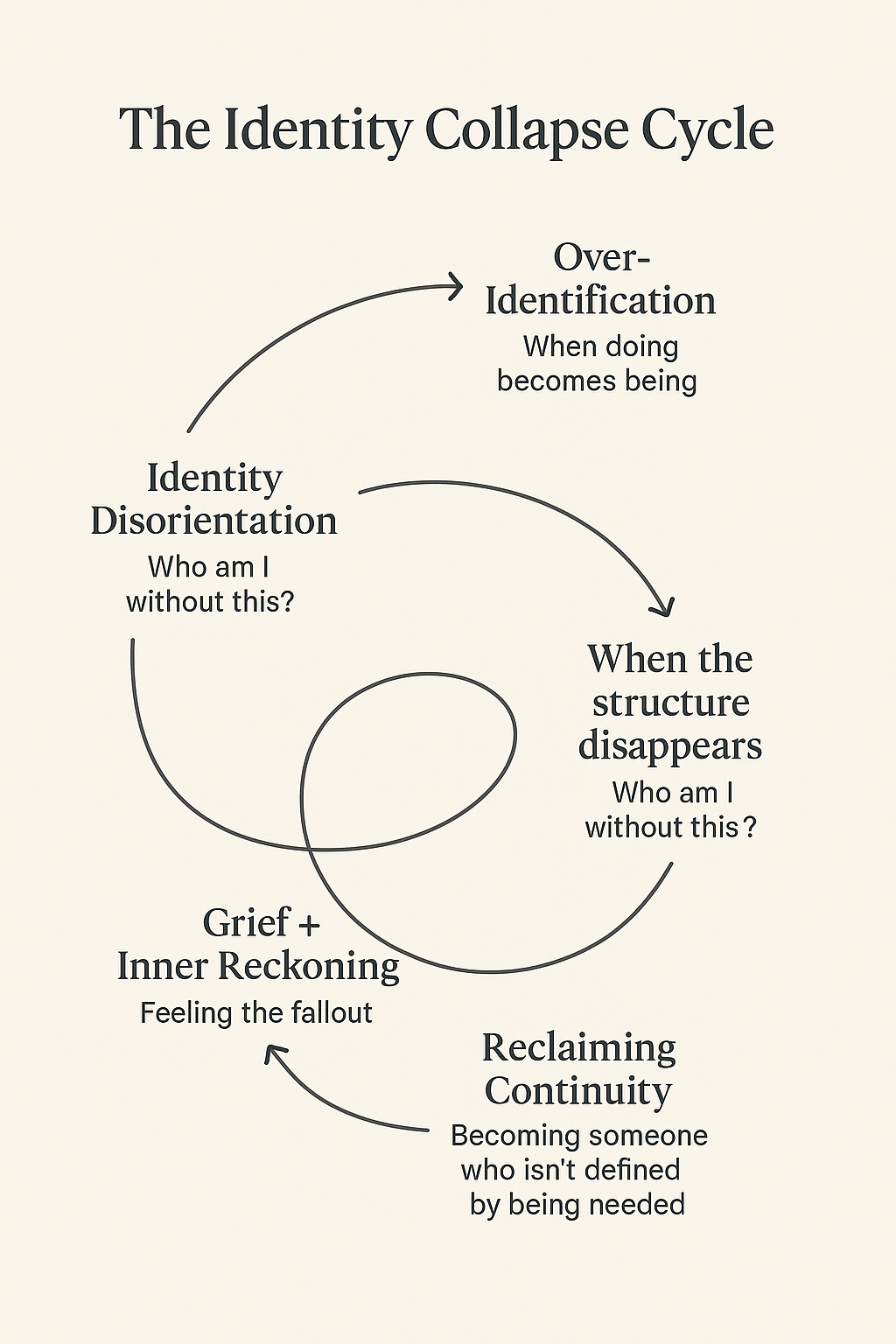
The Identity Collapse Cycle
When a role ends and you no longer know who you are.
When a Role Becomes Your Whole Life
There are roles we choose, and roles that choose us. Sometimes they begin with a job offer, a marriage license, a baby’s first cry. Other times, they form slowly, invisibly, over years—until one day we realize we’ve built an entire identity around showing up in a certain way. You become the reliable one. The teacher. The caretaker. The achiever. The strong partner. The parent who knows what to do. And with enough repetition, that role stops feeling like a role. It starts to feel like you.
And then, something changes.
The job ends. The marriage dissolves. The kids grow up. The structure you organized your days, your energy, and your value around disappears. And what’s left isn’t just empty space. What’s left is confusion. Grief. Silence. Maybe even panic. It’s not just that you don’t know what to do next. It’s that you no longer know how to be. Not in the deep, existential sense of “Who am I?” but in the hour-by-hour sense of “How do I move through a day when I’m not being that version of myself?”
This is the collapse. Not of your worth, but of the framework that used to hold it. The identity collapse cycle doesn’t begin with reinvention. It begins with disorientation. And the mistake most people make is trying to fix that disorientation too quickly. Trying to replace the old role with a new one, find a new purpose, define a new self. But when identity has been over-attached to a role, the work is not to leap forward. It’s to come back. To the person you were before you started performing. Before you started defining yourself by usefulness, contribution, or consistency.
There’s grief in this process—grief for the life you shaped around that role, and for the version of you that lived inside it. But there’s also potential. The potential to uncover a deeper, more resilient self. One that isn’t as easily collapsed by changing seasons, shifting relationships, or the unpredictability of life.
This page maps what happens when a dominant role dissolves, how it can fracture your sense of self, and what it means to rebuild a new identity—one that doesn’t depend on being needed, admired, or useful. One that comes from within.
Cycle Stages
-
You didn’t mean to lose yourself in the role. It just happened slowly—through repetition, responsibility, and recognition. Maybe it was parenting. Maybe it was a job. A relationship. A leadership position. Whatever it was, you became known for showing up in a particular way. And over time, it stopped feeling like something you did. It started feeling like who you were.
This stage is marked by:
Fusion of self and function:
You begin to equate your worth with your usefulness, productivity, or role in others’ lives. You feel most “yourself” when you’re needed, relied on, or praised.Loss of personal language:
You talk more about your role than your preferences. Sentences begin with “I have to,” not “I want to.” Desires feel distant. Identity becomes reactive.Safety through purpose:
There’s emotional grounding in the routine, the checklist, the ability to contribute. Even when exhausted, the role offers stability. You belong—because you’re doing something that matters.Red flags:
You feel uneasy when not “on duty.”
You minimize your needs to stay available.
You fear what would happen if this role disappeared.
This isn’t about blame. Over-identification is often how people survive chaos, abandonment, or uncertainty. It works—until it doesn’t. And when that role dissolves, the collapse begins.
-
The role doesn’t always end in a single moment. Sometimes it fades. Sometimes it’s taken from you without warning. Sometimes you choose to leave it, thinking you’re ready—only to discover how much of yourself was tied to it.
This is the moment when the scaffolding falls. The job ends. The kids leave. The relationship breaks. The daily purpose disappears. And suddenly, the rhythm that held your life together is gone.
This stage is marked by:
Sudden spaciousness:
Time opens up, but not in a liberating way. There’s a quiet panic beneath the stillness. You wake up and wonder: what now?Disruption of identity routines:
Your habits no longer make sense. You dress differently. You move through space more slowly. Conversations feel awkward. You hesitate when someone asks what you do or how you're doing.Emotional contradiction:
You may feel relief and grief at the same time. Freedom and fear. People expect you to be excited about the next chapter. But all you feel is absence.Red flags:
You start filling your time impulsively—projects, travel, commitments—just to escape the void.
You numb out through distractions, telling yourself you’re “just adjusting.”
You avoid talking about the change because it feels too slippery to explain.
Role dissolution doesn’t just remove structure. It removes the mirror you used to see yourself in. What’s left isn’t always clarity—it’s a blankness that asks to be reckoned with.
-
Once the role is gone, a strange kind of silence settles in. Not just in your calendar, but in your sense of self. The world keeps moving. People assume you’re adjusting. But inside, everything feels scrambled. The cues you once used to navigate your life—what to do, how to behave, who to be—no longer apply.
This stage is marked by:
Emotional fog:
You’re not sure what you feel, only that something is missing. Joy feels muted. Focus slips. You question your reactions and second-guess your instincts.Loss of self-referencing:
You don’t know how to talk about yourself anymore. Even casual questions—“What do you do?” “What are you up to lately?”—create a kind of quiet panic. You hesitate, fumble, or deflect.Internal noise, external quiet:
On the outside, you may appear calm. But internally, you’re flooded with uncertainty. There’s shame for not “having it together.” You worry you’ve somehow failed at resilience.Red flags:
You overcompensate by presenting confidence you don’t feel.
You keep waiting for the old clarity to return—but it doesn’t.
You feel like a ghost inside your own life.
This isn’t dysfunction. It’s disorientation. Your brain is trying to rebuild a map with landmarks that no longer exist. And like any recalibration, it takes time. The key is not to rush it, or bypass it—but to stay with it long enough to hear what this emptiness might be clearing space for.
-
Eventually, the fog gives way to feeling—but not always in the way you expect. It doesn’t arrive as a clear emotional release. It arrives in fragments. In the middle of the night. In the grocery store. In conversations that suddenly sting. This is the stage where the grief surfaces—not just for the role you lost, but for how much of yourself you gave to it.
This stage is marked by:
Delayed emotional processing:
The grief comes late and often catches you off guard. You may cry over things that seem unrelated or feel anger at people who don’t understand what you’re going through.Emergence of suppressed emotion:
Resentments you didn’t know you had start to surface—about how much you gave, how little you asked for, or how invisible your effort was. This isn't just sadness. It's reckoning.Attempts to bypass or replace:
It’s tempting to jump ahead. To start a new project, chase a new identity, find a quick sense of meaning. But every shortcut around grief becomes a detour that leads back to it.Red flags:
• Saying “I’m fine” while feeling nothing inside
• Comparing your grief timeline to others’ expectations
• Fixating on “next steps” to avoid being still
• Feeling embarrassed by how much this is affecting youGrief doesn’t mean you regret everything. It means you’re honoring the ending. Inner reckoning doesn’t mean self-blame—it means recognizing where you disappeared inside the role, and beginning to return.
-
Eventually, something shifts. Not all at once, and not with fanfare—but slowly, you begin to sense yourself again. Not as a role, a title, or a task list—but as a person with an interior life that doesn’t need external permission to exist. This is not reinvention. It’s reinhabiting.
This stage is marked by:
Emergence of internal rhythm:
You begin to rebuild your life from the inside out. Not based on what others expect of you, but on what feels real, nourishing, and true. There’s less urgency. More discernment.Personal rituals of meaning:
New patterns form that are not about productivity or service. You reclaim hobbies, creativity, slowness, solitude. You explore values that had no space before. You begin to choose—not just respond.Self-definition without performance:
You start answering questions differently. “What do you do?” becomes less threatening. You realize you can tell the truth, even if it’s messy or unfinished. You no longer need a tidy role to legitimize your presence.Red flags (still possible here):
• Feeling guilty for prioritizing your own joy
• Wondering if life will ever feel “as meaningful” again
• Occasionally reaching for old identities when uncertain
• Worrying you’re being self-indulgent by slowing downContinuity isn’t about becoming your “old self” again—it’s about finding the thread that was always yours, even when hidden by function. It’s about becoming someone whole enough to evolve, without disappearing in the process.

